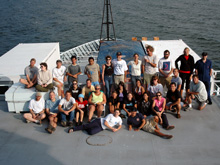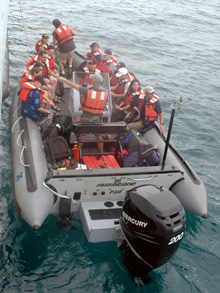
Team members of the GalAPAGoS expedition pose for a group shot on the RV Thompson's 03 deck. Click image for larger view and image credit.

Science and crew members depart the research vessel, board the Thompson's dinghy and head back to shore for the first time in weeks. Although the cruise is over, the research is far from complete. Scientists will spend the following months and even years poring through and analyzing their collected data to learn more about what it means, perhaps making new discoveries back on shore. Click image for larger view and image credit.
Final Days at Sea
January 10, 2006
Kelley Elliott
Web Coordinator
NOAA Office of Ocean Exploration
The Medea is back on deck after spending the final science days of the cruise exploring the ocean floor for active and extinct hydrothermal vents. Only highly diffuse and inactive vents are discovered during the last hours of operation over the seafloor, however operations go well, and tired but happy scientists and technicians now busily pack and prepare for home as the Thompson steams back to port.
While cleaning and packing ensues around the ship, 25 select crew members are taken aside to partake in their first equator crossing ceremony. 25 “Pollywogs,” or persons who have never partaken in an equator crossing ceremony regardless of whether he/she has actually crossed the equator at sea before, are presented to King Neptune, the Roman God of the Sea. After paying homage to King Neptune, all 25 Pollywogs earn their new “Shellback” title. Equator crossing ceremonies conducted on ships are a time-honored maritime tradition, intended to bond shipmen in a brotherhood, and are believed to have started with the Vikings crossing the 30th parallel. These ceremonies are continued in modern times with the US Navy and most other seafarers.
A full day after steaming past the equator, the Thompson arrives back in Puerto Ayora, Galapagos Islands, and drops anchor. All equipment is packed and spaces are cleaned for the next science party to arrive in a few short days. Members of the crew and science team arrive on the starboard deck with their luggage, don their lifejackets and descend down a ladder hung over the starboard side of the ship to the Thompson dinghy below. The dinghy’s motor is started and the boat is maneuvered away from the Thompson and back towards land. The Thompson fades smaller into the distance as the dinghy steams toward land, and in less than 10 minutes, science and crew will take their first step on land in 25-40 or more days.
The last hours of packing, cleaning and preparing for land make the final time spent on board fly by, yet the excitement is far from over. Scientists from the cruise will spend the following months and even years poring through and analyzing their collected data to learn more about what it means, perhaps making new discoveries back on shore.GalAPAGoS: Where Ridge Meets Hotspot will be sending reports from Dec 3 - Jan 10. Please check back frequently for additional logs from this expedition.
Sign up for the Ocean Explorer E-mail Update List.




























